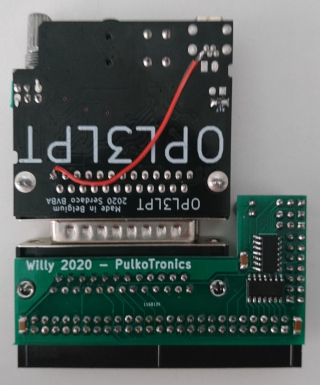Difference between revisions of "Willy"
(→Technical information) |
(→FM Percussion Set) |
||
| Line 41: | Line 41: | ||
=== FM Percussion Set === | === FM Percussion Set === | ||
| − | + | FM synthesis does a great job relative to its hardware requirements at reproducing melodic instruments but isn't especially useful for harsh percussion noises like drums. Yamaha provides separate drum noises for this purpose. The programmer has to forfeit three channels of regular FM synthesis, freeing up six operators for five rhythm instruments. | |
| − | + | A global random level generator is implemented for this mode; it's a standard LFSR just like the noise generator on simple chips like the AY-3-8910 or SN76489, so it provides a one-bit semi-random output. | |
| − | + | ||
| − | * | + | The OPL can then generate: |
| − | * | + | |
| − | * | + | * a bass drum, which is just another FM noise; |
| + | |||
| + | * a tom tom, which is the unmodulated output of a single operator; | ||
| + | |||
| + | * a snare drum, which combines the phase of a single operator with the random noise bit; | ||
| + | |||
| + | * a cymbal which XORs six bits from the phase of two operators; | ||
| + | |||
| + | * a high-hat, which uses the same XOR as the cymbal and combines it with the random noise bit. | ||
<br> | <br> | ||
Revision as of 21:43, 13 October 2024
Willy - MIDI and OPL3 Soundcard adapter for CPC
Contents
Demonstrations
- Willy OPL3 on a real CPC demoed by Prodatron
- Willy MIDI and Willy OPL3 emulated on ACE demoed by Offset
- Willy OPL3 emulated on ACE-DL demoed by Roudoudou
- OPL3LPT soundcard reviewed on PC by ChinnyVision
Weblinks
- https://pulkomandy.github.io/shinra.github.io/willy.html
- OPL3 Player Pack Huge pack containing 3887 OPL2/OPL3 tunes to be played on Amstrad CPC
Cost
The cost for a Willy soundcard adapter is 10€. This does not include any soundcard, you have to buy those separately.
Technical information
2 ports are used to control the MIDI soundcard: &FEAC for data, and &FEAD for control and status.
3 ports are used to control the OPL3 soundcard: &FEBC and &FEBE are register select ports, and &FEBD is the data port.
OPL3 is register compatible with OPL2, with twice the number of signal sources, 4 new operator modes, 4 new selectable waveforms (including square wave) and stereo output.
OPL3 offers 18 FM 2-op chans in its standard mode, but that can be configured:
- One setting converts 3 of the FM chans into a 5-chan FM percussion set
- Another setting pairs 12 of the FM chans into 6 FM 4-op chans
- Both settings can be used at the same time, to obtain 6 FM 4-op chans + 3 FM 2-op chans + 5-chan FM percussion set
FM Percussion Set
FM synthesis does a great job relative to its hardware requirements at reproducing melodic instruments but isn't especially useful for harsh percussion noises like drums. Yamaha provides separate drum noises for this purpose. The programmer has to forfeit three channels of regular FM synthesis, freeing up six operators for five rhythm instruments.
A global random level generator is implemented for this mode; it's a standard LFSR just like the noise generator on simple chips like the AY-3-8910 or SN76489, so it provides a one-bit semi-random output.
The OPL can then generate:
- a bass drum, which is just another FM noise;
- a tom tom, which is the unmodulated output of a single operator;
- a snare drum, which combines the phase of a single operator with the random noise bit;
- a cymbal which XORs six bits from the phase of two operators;
- a high-hat, which uses the same XOR as the cymbal and combines it with the random noise bit.
Compatible Serdaco soundcards
- S2P soundcard aka Roland MT-32 or General MIDI Wavetable Synth - Datasheet
- OPL3LPT soundcard aka AdLib Gold or Sound Blaster 16 - Datasheet
- OPL2LPT soundcard aka AdLib or Sound Blaster - Datasheet
- CMSLPT soundcard aka Creative Music System or Game Blaster - Datasheet
- TNDLPT soundcard aka PCjr or Tandy Sound - Datasheet
- CVX4 soundcard aka Covox Speech Thing - Technical analysis
